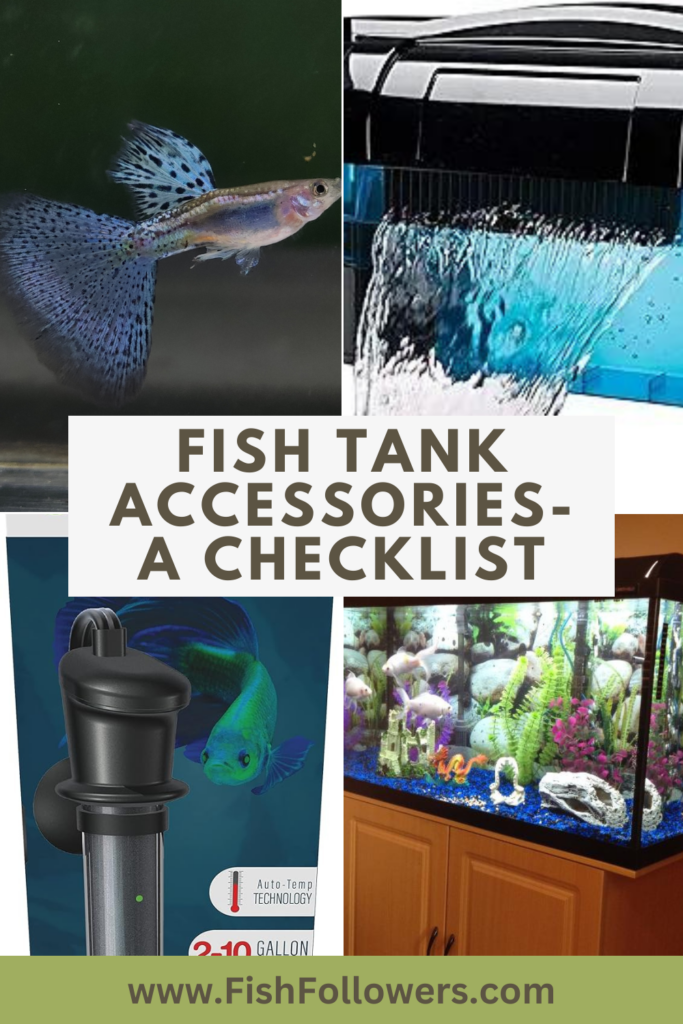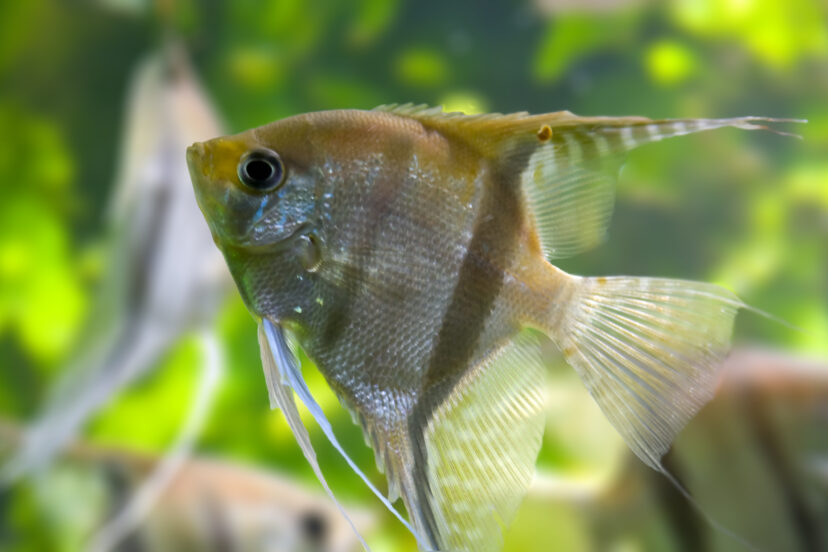An Overview of Fish Tank Accessories- The Checklist
As a passionate freshwater fish guy, I’ve learned that creating the perfect aquatic environment is both an art and a science. Today, I’m excited to share my insights on essential fish tank accessories that will help you create a thriving underwater world for your finned friends. Whether you’re a beginner or a seasoned aquarist, these tips will ensure your tank is not just a container of water, but a vibrant, healthy ecosystem.
Filtration Systems: One of the Most Important Fish Tank Accessories
Let’s dive right in with what I consider the most crucial component of any fish tank: the filtration system. Think of it as the heart and lungs of your aquatic world, keeping the water clean and oxygen-rich for your underwater pals.
Types of Filters
In my years of fishkeeping, I’ve experimented with various filter types, each with its own strengths:
- Hang-on-Back (HOB) Filters: These are my go-to for smaller tanks. They’re easy to install and maintain, perfect for beginners.
- Canister Filters: For larger tanks, I swear by these powerhouses. They offer superior filtration and can handle the bioload of bigger aquariums.
- Sponge Filters: I love these for breeding tanks or housing delicate fish. They’re gentle and provide excellent biological filtration.
- Under-gravel Filters: While less common now, they’re great for planted tanks as they promote root growth.
Choosing the Right Filter for Your Tank
Selecting the perfect filter isn’t just about size; it’s about understanding your tank’s specific needs. Here’s my rule of thumb: aim for a filter that can process your tank’s entire volume at least four times per hour. For instance, a 30-gallon tank needs a filter with a flow rate of at least 120 gallons per hour.
Remember, over-filtering is rarely a problem, but under-filtering can lead to a host of issues. I always err on the side of caution and go for a slightly more powerful filter than I think I need.
Lighting: Illuminating Your Underwater World
Proper lighting isn’t just about showcasing your fish’s colors; it’s crucial for their health and can make or break a planted tank.
LED vs. Fluorescent Lighting
In my early days, I used fluorescent lights, but I’ve since switched to LEDs for all my tanks. Here’s why:
- Energy efficiency: LEDs use less power, saving on electricity bills.
- Longevity: They last much longer than fluorescent bulbs.
- Customization: Many LED systems allow you to adjust colors and intensity, mimicking natural light cycles.
- Heat reduction: LEDs produce less heat, helping maintain stable water temperatures.
Timing and Intensity Considerations
I’ve found that mimicking natural light cycles keeps my fish healthier and more active. I use timers to provide about 8-10 hours of light daily for my community tanks. For planted tanks, I might extend this to 10-12 hours, adjusting the intensity throughout the day.
Pro tip: Invest in a programmable LED system. It’s a game-changer for creating dawn and dusk effects, which can trigger natural behaviors in your fish.
Substrate and Decorations: Creating a Natural Habitat
The bottom of your tank isn’t just for looks; it’s a crucial part of your aquarium’s ecosystem.
Selecting the Perfect Substrate
Your substrate choice depends on your tank’s inhabitants and your aesthetic preferences. Here are my go-to options:
- Gravel: Great for most community tanks, easy to clean, and comes in various colors. I have found the one referenced here as “low dust”… but that is just my opinion. I don’t think it is listed that way.
- Sand: Perfect for bottom-dwelling fish like Corydoras. I love how it looks, but it requires careful maintenance. Again, you can get this in several colors.
- Planted tank substrates: If you’re into aquascaping like me, specialized substrates rich in nutrients are a must for lush plant growth.
Decorations That Serve a Purpose
Decorations aren’t just about aesthetics; they play vital roles in your tank’s ecosystem. But let’s be clear, there are inexpensive decorations and there are crazy expensive decorations. But- they do different things:
- Caves and hideouts: Provide security for shy fish and breeding spaces- this one is inexpensive.
- Driftwood: Adds a natural look and slowly releases tannins, beneficial for many fish species.
- Live plants: Oxygenate the water, absorb nitrates, and provide hiding spots. See this article on LIVE PLANTS.
- NOT Live Plants– These are inexpensive.
- Rocks: Create territories for cichlids and other territorial fish. This is a link to my “rock” article.
- Other décor– this is crazy expensive!
- And- I like the plane! There are more expensive ones… but I think this one looks the best.
I always ensure that any decoration I add serves a purpose beyond just looking good. It’s about creating a functional, stress-free environment for your aquatic friends.
Water Conditioning and Testing Equipment
Maintaining water quality is paramount in fishkeeping. It’s not just about making the water look clean; it’s about creating a healthy, stable environment.
Essential Water Treatment Products
These are the products I never let myself run out of:
- Dechlorinator: Removes chlorine and chloramine from tap water, making it safe for fish.
- Beneficial bacteria supplements: Jumpstarts the nitrogen cycle in new tanks and helps maintain it in established ones.
- pH adjusters: While I prefer to choose fish that suit my water’s natural pH, these can be useful for certain species. I just use this one… I don’t really use the up and down products.
Test Kits for Maintaining Water Quality
Regular testing is crucial. Here’s what I test for at least every other week:
- Ammonia, Nitrite, Nitrate: The big three of the nitrogen cycle.
- pH: To ensure stability and suitability for your fish species.
- KH (Carbonate Hardness): Helps maintain stable pH.
- GH (General Hardness): Important for fish and plant health.
I use the strips– They are plenty accurate. There are liquid tests, but they take a bit more time. The precise readings might be worth it for you if you live in an area with tricky water parameters. Maintaining optimal water conditions can be difficult on some municipal systems.
Maintenance Tools: Keeping Your Tank Clean and Healthy
Regular maintenance is the key to a thriving aquarium. Over the years, I’ve assembled a toolkit that makes cleaning day a breeze.
Cleaning Equipment
Here’s what you’ll find in my aquarium maintenance kit:
- Algae scraper: For keeping the glass crystal clear.
- Gravel vacuum: Essential for removing debris from the substrate. Here is the manual version– and the more automated kind.
- Bucket (dedicated to aquarium use only): For water changes. I just use one of those 5 gal things from Home Depot.
- Nets: Just get one medium sized net. Really the only time you will need it is to scoop and have a quick funeral.
- Pruning scissors: For trimming plants in planted tanks.
- Old toothbrush: Perfect for cleaning decorations and hard-to-reach spots.
Maintenance Schedule Tips
Consistency is key in aquarium maintenance. Here’s a simplified version of my routine:
- Daily: Quick visual check, feed fish, remove any visible debris- or bodies.
- Weekly: Test water parameters, perform a 10-25% water change, clean the filter if necessary.
- Monthly: Deep clean decorations, trim plants, check and replace equipment as needed.
Remember, a clean tank is a happy tank, but don’t go overboard. Over-cleaning can disrupt the delicate balance of beneficial bacteria in your aquarium. Particularly leave the filter alone. I only change the cartridges once a month or so. Bacteria is good!
Conclusion: Bringing It All Together
Creating and maintaining a healthy aquarium is a rewarding journey. By investing in quality filtration, appropriate lighting, thoughtful decorations, and regular maintenance, you’re setting the stage for a thriving underwater ecosystem. Remember, every tank is unique, and part of the joy of this hobby is learning what works best for your specific setup.
As you embark on or continue your fish tank adventure, don’t be afraid to experiment and learn. The accessories and techniques I’ve shared are based on years of experience, but the best teacher is your own tank. Observe, adjust, and most importantly, enjoy the world you’re creating.
FAQs: Your Top Questions Answered about Fish Tank Accessories
- How often should I replace my filter media? It depends on the type of media, but generally, mechanical media like sponges can be rinsed monthly and replaced every 3-6 months. Biological media should rarely be replaced to preserve beneficial bacteria. That’s where the good stuff is! Remember, don’t replace these unless you REALLY have to.
- Can I use regular sand from the beach in my aquarium? I wouldn’t recommend it. Beach sand can contain pollutants and marine salt. It’s safer to use aquarium-specific sand to avoid introducing harmful elements to your tank. Just get a couple of these and go with it. There are different colors too. And the best part is they deliver to your front door!
- Do I need a heater in my tropical fish tank? Absolutely. Most tropical fish require consistent temperatures between 75-80°F (24-27°C). A reliable heater is essential for maintaining this range. The one linked is a workhorse- I have never had one break.
- How long should I leave my aquarium lights on each day? I typically recommend 8-10 hours for community tanks and 10-12 hours for planted tanks. Use a timer to maintain consistency and mimic natural day/night cycles.
- Is it necessary to use a water conditioner with every water change? Yes, always use a water conditioner when adding tap water to your aquarium. It neutralizes chlorine and other harmful chemicals that can stress or harm your fish.
Fish Tank Accessories Checklist
Here’s a printable checklist to help you keep track of essential fish tank accessories:
- [ ] Filtration system appropriate for tank size
- [ ] Heater (for tropical tanks)
- [ ] Thermometer
- [ ] LED lighting system
- [ ] Timer for lights
- [ ] Appropriate substrate (gravel, sand, or planted tank substrate)
- [ ] Decorations (caves, driftwood, rocks)
- [ ] Water conditioner
- [ ] Test kit (ammonia, nitrite, nitrate, pH, KH, GH)
- [ ] Gravel vacuum
- [ ] Algae scraper
- [ ] Fish net
- [ ] Dedicated aquarium bucket
- [ ] Beneficial bacteria supplement
- [ ] Pruning scissors (for planted tanks)





